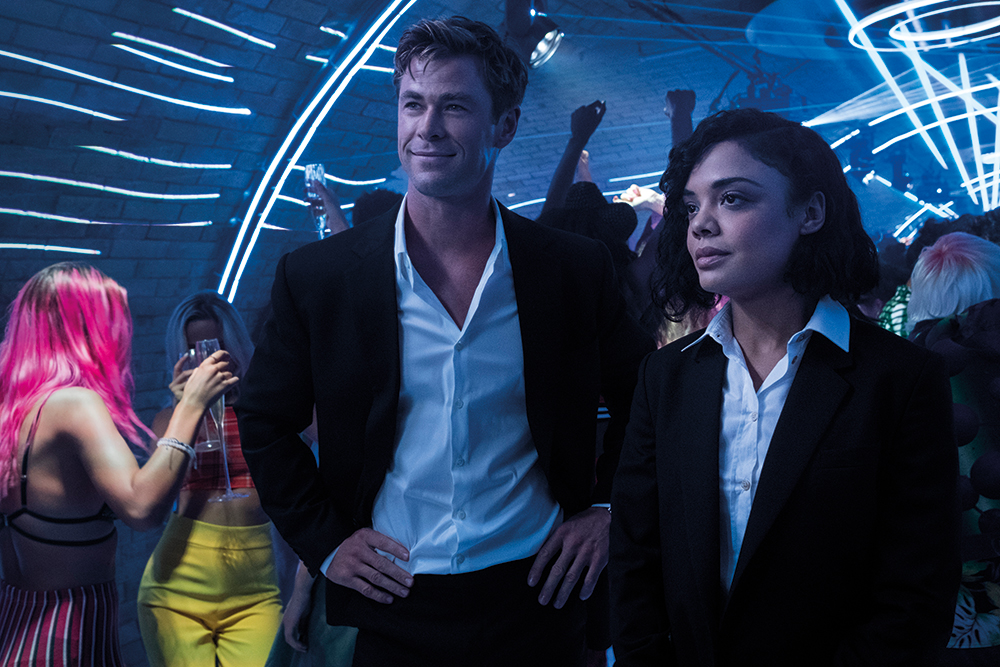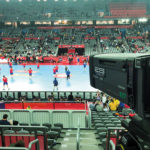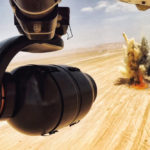
Changing of the guard
Posted on Jul 22, 2019 by Julian Mitchell
The Men in Black franchise had to change to keep it fresh. But how to do it without disenfranchising the fans?

Words Chris Jacobs / Pictures Sony Pictures
Men in Black is now a 20-year-old franchise, which means that, for Men in Black: International, things had to evolve… but also stay the same. So, bring in some new characters – this time a couple of ex-Avengers: Valkyrie (Tessa Thompson) and Thor (Chris Hemsworth). Take the whole show to London and Morocco – hence the ‘international’ title extension – and bring in a new director and director of photography: F Gary Gray and Stuart Dryburgh.
“That big chip on the Alexa 65 pulls in a lot of detail, so things don’t get muddy”
Check out Dryburgh’s IMDb entry and his experience speaks for itself, with films like The Piano, Bridget Jones’s Diary, The Portrait of a Lady and, more recently, The Great Wall, directed by Yimou Zhang and the first full feature to be made with the Arri Alexa 65 camera. Dryburgh’s experience and his knowledge of the Alexa 65 held him in good stead for MIB, as he explains: “The camera has three Alexa sensors, so is truly a high-definition camera with very little aliasing and no compression. Optically, it performs like a medium format camera, so a really wide lens would be, say, a 28mm, a 24 would be an extremely wide lens and a standard lens would be around 80 or 100mm. It has a short depth-of-field like anamorphic, but it’s not anamorphic: it’s spherical. It’s a lovely camera.”
 Dryburgh chose the Alexa XT with a Sigma 300-800mm stills lens as part of the Morocco shoot
Dryburgh chose the Alexa XT with a Sigma 300-800mm stills lens as part of the Morocco shoot
The Great Wall link
The Great Wall and MIB: International had the same line producer, who recommended Dryburgh when the original cinematographer didn’t work out. When The Great Wall came out, it’s fair to say the reviews were mixed, but it is a glorious-looking film thanks to Yimou Zhang, who also directed Hero and House of Flying Daggers. Dryburgh hinted at the care the director showed with The Great Wall: “It was a beautiful movie and Yimou Zhang was so careful with his choice of colours with costume designer Mayes C Rubeo, especially for the uniforms of the different types of soldier. He was terrified of people thinking they were Power Rangers.
“Yimou Zhang is famous for working with colour, but normally only one colour at a time. If you look at Hero, shot by Christopher Doyle, there are different colour themes throughout the film, but in The Great Wall, Zhang wanted the different parts of the army identifiable by their uniform colour,” Dryburgh explains. “We helped by adding an overall colour wash to the lighting, which desaturates the colours a bit. Also, that big chip on the Alexa 65 pulls in a lot of detail so things don’t get muddy. All the separations are there without the usual aliasing advancements of a digital signal.”
Using such a new type of camera for a feature had its own problems, not least the choice of lenses to cover such a large sensor. Arri did have lenses for the camera – the 65 Primes – but a set of 765s were also available, which were lenses from Arri’s 70mm cameras from the eighties. “They were compatible with the Prime 65 lenses. We only had those lenses, but they were very good and we had a wide selection of focal lengths,” says Dryburgh.
The other big question Dryburgh had to deal with was how to archive such a large amount of data. “As I do with all my Alexa 65 shoots, we use LTOs and archive at 4K,” he explains. “No one wants 6.5K. It’s great as a form of oversampling of the image at the capture end, but there’s really no particular value in keeping it that way. I have offered studios an archive of the 6.5K just in case they ever need that resolution, but no one has been that keen to spend money on extra storage.”
 Actress Emma Thompson is the only cast member remaining from the previous films
Actress Emma Thompson is the only cast member remaining from the previous films
MIB Challenge
With a new director and DOP, what could they bring to the MIB franchise without changing it too much? “On one level, it needed to be true to the franchise and to the style of the franchise – recognisably from the same stable of movies, but this was a reboot,” says Dryburgh. This meant none of the original characters were used, except Emma Thompson. But how do you inject new life into it? “That was certainly [director] Gary’s aim and was his brief to me, but once we became ‘international’, it becomes much more opened up in places like London, and especially Morocco.”
“On one level, you need to be true to the franchise and to the style of the franchise, but this was a reboot”
Being true to the previous movies meant lots of VFX, a task made easier thanks to virtual production introducing many aids for filmmakers. “It’s getting easier,” Dryburgh says. “I’ve been dealing with VFX on a crude level with chromakey and Ultimatte since I was shooting TV commercials back in the eighties. We used to shoot chromakey for film and Ultimatte in the digital realm, so I’ve done all that for a long time. There’s a lot more tolerance from the VFX side – you don’t have to have a perfectly exposed blue or green screen, stuff like that. There’s other tools of the trade now like pre-vis, it’s fantastic in prep where you’re essentially doing an animated version of your action scenes.”
He continues: “There are also various forms of sketch-up projection, which allows you to see your actors in a virtual wire-framed set with the ability to still move the camera and have the actors move. It’s definitely getting there, all that technology, and will only get better. It takes the guesswork out of things – I used to have to take acetates and put them over the monitor and then draw the set in.”
MIB – from the air
Aerials shot were taken by Helicopter Film Services, with Jeremy Braben as the aerial director of photography. The team shot in locations such as London, Morocco and Ischia, as well as Italy for a speedboat scene with actor Chris Hemsworth. Shooting was done in conjunction with the main and second unit, where the second unit director was Wade Eastwood and the second unit DOP was Lucas Jogalla.
Helicopter filming used the Arri Alexa 65 and Alexa Mini on a Shotover mounted on an Airbus Squirrel. Drone filming used the Aerigon heavy-lift drone with a Movi Pro gimbal carrying an Alexa Mini and Master Prime lenses. Alan Perrin was the drone pilot.
The drone sequences were all filmed in Morocco, with some aerial plates filmed in the desert dunes. And in Marrakech, plates were filmed for action sequences in the Medina. In London, the team filmed plates for the Hyperloop sequence – an underground train that moves at hyper speeds. The team used the Shotover K1 gimbal with the Arri Alexa 65.
However, there were location issues, as travelling between locations was difficult in Morocco – from Tangier in the north to the desert. The team battled with local congestion, crowds and sandstorms that appeared out of nowhere. The locals seemed to know when a storm was on its way before the production. Jeremy Braben, comments: “When it came, it was like having wet sand hurled at you at 50mph. There were a lot of rashes on the legs of crew and sand in equipment!”
 Above and below: drone and aerial crew, including Jeremy Braben (aerial DOP); Alan Perrin (drone pilot); Oliver Ward (chief aerial technician – helicopter); Taylor McClean (drone camera assistant) and Derek Desmond (aerial operations)
Above and below: drone and aerial crew, including Jeremy Braben (aerial DOP); Alan Perrin (drone pilot); Oliver Ward (chief aerial technician – helicopter); Taylor McClean (drone camera assistant) and Derek Desmond (aerial operations)

 Actor Chris Hemsworth in a speedboat, shot from above
Actor Chris Hemsworth in a speedboat, shot from above
Challenging scenes
One of the aims of the reboot was to expand out of the old environments from MIB 1, 2 and 3, which are largely set in New York City. Dryburgh particularly enjoyed the night scenes in London , as well as the shoot that took the whole production over to Morocco. “It was a lot of fun shooting night exteriors on a street in London,” he recalls, “but particularly challenging as we shot in summer, which meant we had short nights – and only a limited number of nights – so we had to do loads of work. But I always enjoy shooting in the real world.”
“It was fun shooting night exteriors on a street in London, but challenging as we shot in summer, so had short nights”
For the London night shoots, Dryburgh had to wait for the sky to become a very dark blue before he could start shooting. To prepare, he visited the street at night well in advance and took some digital stills, approximating the camera EI and speed. “Also seeing what the natural light had to offer, because it’s quite a well-lit street. Then we looked at what we wanted to keep and take away, and there were some street lights that were right overhead of where we were shooting we didn’t really want,” he explains.
To work around the unwanted streetlamps, the team utilised some big lights and some smoke, then hid more lights up in alleys and shopfronts, trying to keep the lighting as natural as possible. Dryburgh says: “But we definitely added to the natural lighting that was there. This was very much a classic night shoot, but one that follows the style of the film. There’s not a lot of fancy camera moves, but a lot of classic square-on framing. We looked at the early movies and some Cohen Brothers movies for that as well as reference.”
 Above and below: to shoot at night, Dryburgh had to wait for the sky to become a very dark blue
Above and below: to shoot at night, Dryburgh had to wait for the sky to become a very dark blue

As for Marrakech, it was “terrific”, but not without challenges. One of the scenes for MIB: International takes place in the Medina, but it was impossible to get a truck within a mile of where the team was shooting. “We used carts and motorcycles to move everything,” recalls Dryburgh.
“For Marrakech, we mostly shot in the Medina in old market streets. Getting gear in every morning was a hike. There was virtually no set dressing involved, because the bare bones of the place was so great.” Although, he admits, “we did have to cram a bit of light in some of the darker corners, which I think we managed to do successfully, as it didn’t look too lit up”.
Dryburgh adds: “It was great that we got to go there, because you couldn’t have got that on a sound stage. Even if there were those shots of Tess and Chris on the jet bike, which were shot on blue screen and composited in, all of the background plates and stunt work were in Marrakech. And the desert is always amazing to shoot in.”

What is Stabileye?
“In the few years that Stabileye has been a part of the film industry, it has been used to good effect with ever more demanding scenarios. Through the creative ideas of the end users, it has seen more and more involvement with long takes that evolve. For instance from a crane shot to a walking shot, or starting inside a room and being passed through a window and onto a wire rig, only to be handed off to a tracking vehicle for a fast finale.
“Right now we’re involved in a number of fantastic productions. We are being put through our paces on some complicated sequences in the trenches. Another project has seen us filming a horse race over a few days,” says Stabileye co-director, David Freeth. “The camera operators and first ACs were set up in a chase vehicle, while Stabileye was in the hands of the grips, who were tracking long lenses among the horses on a mule-tracking vehicle. Eventually, Stabileye was placed in the hands of the jockeys and
we did some close shots at full gallop. The quality of stabilisation was perfect and the footage was stunning.
“Stabileye isn’t a ‘gimbal’ in the typical sense; it’s a miniature stabilised head. It has a set of hand wheels and relies on an operator to operate them, but from time to time we are asked if control could be given to a person carrying the head. This is something Stuart asked for and it gave him the dynamic response he needed for his shot.”
 Stabileye in use for Guardians of the Galaxy Vol. 2
Stabileye in use for Guardians of the Galaxy Vol. 2
Camera moves
When filming in so many locations, using the right gear is paramount. For Dryburgh, moving the camera was a matter of using his favourite technocranes, hydrocranes and Scorpios in combination with Libra gimbal heads, as well as a Stabileye. “I think it was built to be a large drone rig, but ran into issues with the CAA in the UK,” he explains. “However, it’s a really good camera rig you can either use like a Movi [pick it up and run around with it], or you can put it on a little trolley or cable. You can rig it as a cable cam in minutes and we used it a lot for that.”
“You can rig the Stabileye as a cable cam in minutes and we used it a lot for that”
Rigging it as a cable cam proved to be a great timesaver. “Most cable cam rigs require construction and huge winches, but the on-set grip crew could rig the Stabileye in ten minutes. It works better with an Alexa Mini than a 65 and we made that compromise when we used it. There’s a shot in a nightclub where I just picked it up and ran through the dancers holding it, simulating a missile POV. It’s brilliant and the size of a Movi, but way better than a Movi,” enthuses Dryburgh.
 Above and below: stills from Men in Black: International
Above and below: stills from Men in Black: International

Glass pick
As for lenses, Dryburgh mainly used Arri Rental DNA glass for MIB: International. “These are all rehoused and rebalanced vintage lenses, but they look good and have some character to them – a lot more character than the Prime 65s did. They flare a bit more and are less colour consistent through the range. We could have had them de-tuned but decided against it as we wanted them as good as they could be,” he adds.
You could even say the new film looks out of this world…









